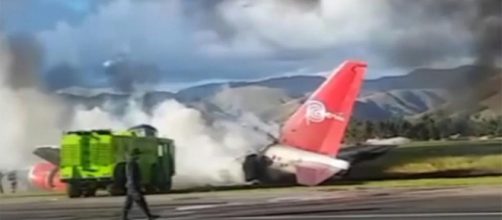There were no serious injuries among the 141 passengers of a Peruvian Airlines flight that burst into flames on Wednesday. The first broke after the Boeing 737-300 made a forced landing at the Francisco Carle Airport in Juaja, Peru. The ill-fated plane came from the Peruvian capital of Lima.
Forced landing
Alberto Lopez, the spokesperson of Peruvian Airlines, said the aircraft did not crash. The fire was produced after the jet made a forced landing. He said the exact cause of the fire would be explained after the completion of an investigation. In a tweet, Boeing said it is aware of the accident involving Peruvian Airlines Flight 2036, and its team is currently gathering more information, The Telegraph reports.
Aviation mishaps, such as plane crashes, are one of the risks of air travel. The Peruvian Airlines passengers are lucky that no one among its passengers was seriously hurt. Barely four months ago, another South American nation was hit by tragedy when 81 people aboard an airplane crashed in Colombia on its way to the Jose Maria Cordova Airport.
The plane had nine crew members and 72 passengers, including the entire Brazilian Football Team, Chapecoense, who were preparing to play against Atletico Nacional at the Copa Sudamericana finals game. Reports said that six people survived the plane crash. After a stopover in Santa Cruz, Bolivia, the plane sent an emergency message at around 10 p.m. for an Emergency Landing.
Emergency landing capital of the world
Had the plane carrying the Brazilian football team been in the vicinity of Maine, it could have had a better chance of survival like what happened to the Peruvian Airlines flight. It is because Bangor Airport in Maine is considered the emergency landing capital of the world.
The location has something to do with why the airport in New England is a perfect gateway to deal with any emergency situations, The Telegraph reported.
Besides being perched on the north-east corner of the U.S., the airport also has a 3.5-kilometer runway. It also helps that since 2005, the Bangor Airport staff has extensive experience dealing with aviation emergencies. In the last 12 years, the airport handled 1,170 diversions of emergency type flights, 22 security-related incidents, 709 fuel emergencies, 254 weather-related incidents, 95 medical and 90 mechanical problems.
Tony Caruso, the director of the Bangor Airport since 1996, added that besides the long runway and the gateway not being congested, it enjoys support from the Federal Aviation Authority. Bangor’s infrastructure allows the airport to service any military or civilian aircraft.

